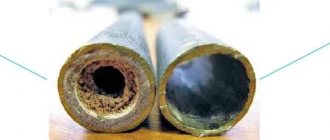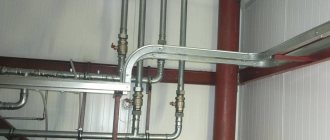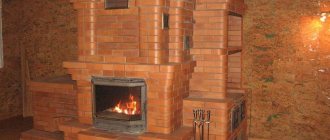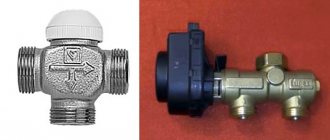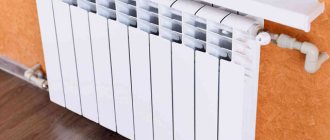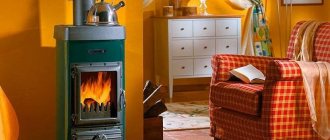An autonomous heating system has many advantages, including the ability to regulate temperature, and, consequently, saving money on fuel consumption. Steam heating, among other things, is an effective method of heating a home due to its low installation cost. In addition, if a conventional stove is installed in the house, you can install steam heating from it yourself, despite the difficult installation.
The difference between steam and water heating
The operating principle of a steam heating system is as follows: water brought to a boil in a container is converted into steam, which then enters the heating radiators, heating them. There, the steam condenses, transforming into a liquid state, flows into the expansion tank through specialized outlets, and then goes back to the heat exchanger.
The difference between steam heat supply and water heat supply is considered to be, first of all, the circulation of different types of coolant. Secondly, the heat transfer is higher, and the rate of warming up the room is 3-4 times faster than that of a water heater. With similar costs for solid fuel, the efficiency of steam heating is greater than that of water.
To install steam heating, no large-sized equipment is required, which makes this heating system economical. If the system is inactive, pipes with water coolant may freeze over the winter. In contrast, a steam system can be started without much effort without such difficulties.
There are also certain disadvantages that a heating system with water coolant does not have:
- Heating radiators heat up over 100 degrees, which can be unsafe for those around.
- The heating system is very noisy
- Changing the temperature is difficult
- Inability to install a heated hydraulic floor system.
- Plastic pipes cannot be used for the system.
- An oven with a built-in steam heating system is difficult to use at the same time to cook food.
Main components
The key component of the system is the boiler. Its main purpose is to convert water into steam. Later it goes into the pipeline.
The boiler must be powerful enough to pull two floors at the same time
The design elements here are:
- pipe system;
- collectors;
- drum.
Steam space
Additional equipment can be installed here. It can be useful if steam separation is required. Intensive exchange between steam and water is the basis of boiler operation. Heating devices are divided into water- and fire-tube. In the latter case, heated gases move in pipe channels arranged in a container of water.
Water tube modifications work on a slightly different principle. Here water moves through channels built inside a chamber with gases. First it heats up, after which it begins to boil. Water moves naturally inside the boiler.
In all types of boilers, the same rule for converting water into steam applies. First, the liquid is carried into a reservoir located in the upper zone of the device. It then flows into the collector and rises into the drum located at the top, moving through the heating area. Steam is formed inside the pipe and goes up. It can move through a separator where it is separated from the liquid. Then it goes into the steam pipeline.
Heating can be easily installed with your own hands
The boiler can use various fuel options. In accordance with these features, the design can be modified. Changes may also affect the type of operation of the combustion chamber. Let's say a grate is required for those cases where solid fuel is used. At the same time, special burners will be needed if the fuel is gaseous or liquid. Mixed options are more convenient and practical.
Radiators and pipe system
Temperature indicators in the steam system are within +100…+130°C. Compared to water ones, they are much taller. That is why it is not recommended to use similar equipment for arranging systems. This applies to pipes made of polypropylene and metal-plastic. The maximum performance indicators of these materials are within +90…+100°C; their use is strictly prohibited.
Condensation formed inside the parts leads to rapid destruction of the pipe material. We must not forget that steel is not resistant to corrosion. The aggressive coolant environment enhances this disadvantage. The connection requires welding, which requires a lot of time and labor. It is better to take galvanized steel pipes. These products withstand elevated temperatures and require the use of a threaded connection method. This approach greatly simplifies the workflow. The only thing that can serve as an obstacle to purchasing such products is their high price.
Another ideal option is copper pipes. The material is plastic, not afraid of thermal influences, durable, and not subject to corrosion. Soldering is used to connect copper components. Copper piping is durable, but expensive.
Do-it-yourself steam heat supply from a stove
In order not to install a heating boiler for the installation of a steam heating system and spend working capital on this, you can use the stove available in the house. It will act as a heat source with cheap solid fuel, moreover, it does not depend on the central gas and electricity supply. The steam generator is a heat exchanger, which can be made to order or in-house. The disadvantages of a stove-steam boiler are similar to those of a direct combustion stove or fireplace: the inability to accurately regulate the heating temperature, the lack of complete fire safety, and also the possibility of smoke in the room due to incorrect kindling. Similarly, a boiler stove has the same number of disadvantages as an ordinary one, but there are many more positive qualities.
Steam heat supply from the stove
Before steam heat is supplied from the stove, the heat exchanger should be analyzed for leaks. This can be done this way: kerosene is poured inside the device, and the seams are outlined with chalk. Places where the chalk has darkened indicate a leak, which means that this device cannot be used for a steam heating system.
To remove steam heat from the stove, the following components will be required:
- Heating batteries. Their number should be equal to the number of windows in the room.
- Heat exchanger
- Copper or tin pipes for condensate drainage and steam lines.
- Shut-off valves (air bleed valves, valves)
- Connecting fittings: elbows, pipe clamps, fittings.
- Spider fasteners for heating devices
- Hydraulic valve
- A reduction-cooling unit, thanks to which steam is converted into a liquid.
- A reducer to reduce the pressure from inside the system.
- Pump for circulation of forced type liquid.
- Welding inverter
Before starting work, a connection diagram and pipe installation are developed in advance. The drawing determines the location of the furnace-boiler, from which the wiring diagram with all the required connection elements is laid down. For heating an area of no more than 80 sq.m. A single-pipe connection diagram for heating devices is suitable. With this connection method, convector heaters heat up gradually, the first of them being stronger than the others. The two-pipe scheme is suitable for heating rooms larger than 80 sq.m. and two-story houses. The pipes are connected to the design radiators in parallel. If it is intended to install a system based on the principle of gravity circulation, the heat exchanger must be placed below all radiators and pipes at an inclined angle. In this case, it is necessary to install a pump for trouble-free circulation of the heating system.
After the scheme has been developed and all the structural details that are needed to assemble the heating system have been taken into account, you can make an estimate for the purchase of materials and begin to work.
After the scheme has been developed and all the structural details that are needed to assemble the heating system have been taken into account, you can make an estimate for the purchase of materials and begin to work.
Work methodology
It is worth considering that installing a steam heating system without dismantling the old stove is unrealistic. In order to build in a heat exchanger, you need to install it inside the combustion chamber at the furnace lining step.
Heating devices are installed under each window, to which inlet and outlet pipes are connected at a slight slope of 3mm. Each heating device is equipped with an air bleed valve.
Steam heat supply from the stove
To protect the system, shut-off valves are installed in front of each convector heater and in front of the entire system in general. A cooling reducer and pressure reducing valve are also installed at the beginning of the system. At the end of the system, a container is placed to collect condensate with a similar small slope as the pipes. From it, water flows into the heat exchanger. A pump is installed in front of the stove in a forced-type circulation system.
Features of low pressure systems
A common version of such a system is closed, using gravity return of condensate to the boiler, which does not completely fill the pipes, and an upper pipe distribution is used.
First, the system is filled with water to the required level, after which heating begins. The condensate flows down a common riser and, when a predetermined level is reached, is forced into the boiler.
In the same system with bottom distribution, it is recommended to install pipes with a slight slope in the direction of steam movement in order to reduce noise effects. At the point where the condensate is drained, a loop-shaped water seal is installed, which prevents the movement of steam onto the condensation line.
The steam velocity in such systems should be moderate, no more than 0.14 m/s. Otherwise, the steam will also capture particles of moisture accumulated on the walls. As a result, the system operates with more noise and increases the risk of water hammer.
Combined wiring, i.e. a combination of upper and lower wiring is used if pipes are laid under the floor of the upper or middle floor of the house. The lumen of the pipes through which water returns to the boiler will in this case be closed by condensate.
If the pressure in the system exceeds 0.02 MPa, it should be made open. The air is removed through a condensate storage tank, and to prevent steam from leaving the system, a condensate drain or water seal is installed. Water from the storage tank is pumped into the heat exchanger, which allows the storage tank to be installed below the level at which the heat exchanger is located.
The coolant for heating a private house with a boiler room is heated in a heat exchanger located in the boiler room. Upon reaching the operating temperature, the steam moves to a manifold that divides the flow into two circuits: for the main rooms and for the boiler room (+)
Adviсe
The chimney of a stove with an installed steam generator needs to be cleaned of soot more often. In order to ensure free flow of condensate to the lowest point, it is better to install the stove in the basement. Installing valves will help prevent dangerous situations from occurring, so it should not be neglected.
When installing a heating system in a wooden house, it is necessary to ensure fire safety measures by protecting wooden surfaces from overheating. To do this, the adjacent wall with the stove and the floor surface must be covered with heat-resistant material. A shutter valve for the combustion chamber and a blower must be installed at the stove. It is better to plan the placement of the stove-boiler not near the load-bearing wall for the convenience of the process of installing the smoke exhaust duct system.
The height of the smoke exhaust should not be less than 4 meters, otherwise the accumulated condensate will enter the combustion chamber. If the stove is located in a neighboring building (for example, a separate heat-generating unit), there is no need to dismantle and move it inside the house. In this case, it is necessary to properly insulate the pipe wire that connects this building with the stove and the house
In order to prevent the coolant from overheating more than 100 degrees, you can change the temperature if you completely close the vent and slightly open the furnace combustion chamber.
Arguments for"
The steam method quickly heats the air in the house.
It is not necessary to demolish the stove, since in addition to the expenditure of effort and time, major repairs may be required.
Due to the absence of mechanisms, any adjustment is carried out manually, which means that the equipment will not break down or malfunction.
This is an option for a dacha or country house, since the presence there is seasonal, and fuel can be stocked up in advance. The heating will not turn off due to bad weather, non-payment of electricity or gas.
Even if the furnace itself is located in a neighboring building, it is possible to install a steam system. The main thing is to take care of thermal insulation.
How to do this is clearly shown in the following video:
https://youtube.com/watch?v=aB1duN9-N4c
Differences between steam and traditional heating
Steam heat supply operates according to the principle:
- First of all, water is heated in a container to a boil and turns into steam;
- steam passes through pipes to heating devices, giving off heat;
- in batteries, steam condenses, turning back into water;
- water flows through the outlets into the expansion tank and goes back to the heat exchanger.
Unlike a water heating system, a steam heating system provides greater heat output, heats the room three times faster, and is ergonomic. It requires small equipment, which, in fact, reduces the price of the system in general. Another plus: in an abandoned house, the pipes don’t freeze when it’s cold outside. Thanks to this, it is easy to start the steam heating supply by arriving at the dacha during winter, and when leaving, make sure that the fuel is completely burned out.
By the way, not only furnaces, but also boilers operating during mining can be used as a generator for steam heat supply. But in most cases, a system of this kind is installed in garages and utility rooms for environmental reasons.
Where is it used?
High efficiency indicators can only be achieved by installing special equipment in production where large volumes of steam are needed. Although, due to the danger, it was forbidden to equip public places and apartments with these types of devices, some large private country houses are quite successfully heated.
The solution is also perfect for implementing steam heating in a country house. But the purchase of components must be approached as seriously as possible; low-quality elements will easily burst at the slightest appearance of rust, since the walls will weaken somewhat.
Disadvantages of steam heating and ways to eliminate them
- heating devices from steam heat up above 100°C, due to which they pose a danger, especially for children and animals;
- the steam heating system does not stop working noisily;
- temperature control is difficult;
- impossibility of installing warm hydraulic floors.
The first disadvantage can be removed by protecting heating appliances and supply pipes with screens. There is a huge range of such decorative interior elements made of wood and plastic.
The noise in the system can be greatly reduced if you use anti-noise spider fasteners for heating devices when installing them, and install the steam generator itself in an individual room.
The 3rd point is hard to remove. But for the 4th, there is a solution - if you wish, warm hydraulic floors can be replaced with infrared film floors.
Attention! It is not advisable to designate a brick stove with a steam generator for heating and cooking at the same time, since it will still be unrealistic to use it in the summer months. Or, you will have to come up with an alternative option for the warm period. For example, perform a summer oven in clean air.
Also, plastic pipes cannot be used in the system; they will not withstand the temperature regime.
We build a coil from iron sheets
The metal layer must be at least 5 mm for this element. When collecting, a 60*40 mm profile and 5 mm pipes are also used; they are designed to remove water and water mass. The overall size of the device depends on the length of the fuel part of the stove.
The metal layer must be at least 5 mm for this element
If the element is ultimately installed in the heating and cooking system, then the optimal solution would be to ensure that the gas warms the coil shelf and goes into the smoke channels, which will be located in front of the exchanger. With this calculation, it is easy to place a surface for cooking.
The part can also be made in the form of a book if you connect the outer panels with tubes or a profile. But with such a structure, the top shelf will be missing. And for optimal cross-country ability you need to place connecting tubes in the upper part. It is better to organize the inlet and outlet behind the heat exchanger or on its side.
Installation diagram of steam heat supply from the furnace
- Natural and forced circulation system
A system operating on the principle of gravitational circulation requires placing the pipe coil below the level of the heating devices and all pipes at an angle. A forced system requires a pump to ensure uninterrupted circulation of the pipe coil.
Schemes also come in one- and two-pipe.
- Single-pipe steam heat supply scheme for a private house
This scheme operates on the principle of serial connection of heating devices. The coolant moves through the pipe, moving from one battery to another. As a result, the first heating device turns out to be the hottest, and the final one is almost cooled down. Due to this, it is best to use this scheme for rooms with a modest area - from 40 to 80 m2.
- Two-pipe scheme
This system is better suited for houses with large areas and two-story country houses. It is distinguished by the fact that the heating devices in it are connected in parallel, using two pipes: inlet and outlet (condenser). In this scheme, the coolant is supplied to all heating devices at the same temperature, since it does not have time to cool down.
How to arrange steam heat supply from a furnace with your own hands
Equipment and materials
For a steam heat supply device you will need:
- heating devices (under each window);
- heat exchanger - essentially a water tube boiler or steam generator;
- pipes for steam and condensate drainage - give preference to materials resistant to high temperatures: galvanized steel or copper;
- elbows, connectors, pipe clamps, spider fasteners for heating devices, shut-off valves: valves, air release valves;
- a hydraulic valve used to allow drying of the steam pipeline;
- pressure reducing valve to reduce pressure in the system;
- reduction-cooling unit;
- inverter device;
- container for collecting condensate;
- pump.
It is better to rent expensive equipment.
Heat exchanger
You will have to make a heat exchanger for a brick stove yourself or choose one. For this you will need metal pipes, a wall thickness of 2.5 mm and an inverter apparatus. You can combine them as in the picture or make them in the form of a coil. The main thing is to monitor the quality of the weld seams. The calculation is performed approximately like this: 1 m 2 of the coil surface delivers up to 9 kW.
After the design is made, you need to check it. To do this, you need to pour water into it and make sure there are no leaks. However, this method is not very informative, because welds may have slag inclusions, which will not be detected in the absence of excess pressure.
The best way to control the quality of seams is using the “kerosene on chalk” method. To do this, you need to chalk all the welds and pour kerosene inside the structure. If there is a tiny pore, the chalk will fade because kerosene will seep into it.
Sequence of work
The heat exchanger is built into the furnace at the stage of its laying directly into the combustion chamber
Next, according to the diagram, heating devices are installed under the windows. Inlet and outlet pipes are connected to them. For gravitational circulation - with a smaller slope of 3 mm per meter. Each convector heater should be equipped with an air release valve.
For safety, it would be a good idea to install shut-off valves in front of each heating device and one in front of the entire system. At the beginning it is also necessary to install a pressure reducing valve and a cooling unit.
At the end of the system, a tank is placed to collect condensate, from which water also flows downhill back into the heat exchanger. It would not be a good idea to use a membrane expander for this purpose, since it is designed for temperatures up to 85 ° C.
In a forced-type circulation system, a pump is installed in the return pipeline in front of the furnace.
How to heat a large house without extra costs
If you install a heat exchanger in the combustion chamber of an existing brick oven and create an external heating circuit, you can create stove heating with a water circuit. In this case, the register mounted in the firebox will serve as a solid fuel boiler. It turns out that two heating systems are concentrated in one place:
- oven;
- water circuit with register.
A water heater built into the firebox can be called a register, a coil or a heat exchanger, but the essence will not change. It serves to heat the coolant, which is supplied to the external heating circuit.
With this device, the brickwork is heated by heated air passing through the chimneys. At the same time, food and feed for livestock are prepared on the top plate of the combustion chamber. At this time, water is heated inside the firebox and sent to the circulation system. A circuit is created in the same way as when installing a conventional hot water solid fuel boiler. The chosen scheme is single-pipe. The peculiarity of circulation is that the entry into the register is significantly higher than usual. Therefore, the height difference in the circulation circuit must be taken into account.
The created combined scheme for heating a private house will allow one stove structure to heat up to 300 meters of living space, especially if a circulation pump is used in the scheme. However, then heating will depend on the operation of electrical networks. In the event of a power outage, the pump can be bypassed.
Such a stove for a home with water heating must work in conjunction with a register, so even in summer the system must be filled with water or the stove heating must be abandoned. The pipes in the firebox will become unusable if water does not circulate through them. Do not forget that the circuit must have an expansion tank.
Invisible moments when operating steam heat supply from a furnace
Brick stoves with a heat exchanger produce more soot in the chimney than in most cases, and it must be cleaned more often.
With a gravity system, the furnace will have to be built in the basement so that the condensate flows freely to the lowest point.
Do not neglect the installation of valves - they are needed for safety and elimination of accidents. Since the pump requires electricity, it is necessary to take into account that if the power is turned off, it will be impossible to stop the operation of the furnace.
Steam heat supply in a wooden house is installed according to a similar principle as in a brick one. You just need to follow fire safety measures - protect wooden surfaces from overheating.
Steam home heating from a stove
Heating with a stove has been used since the moment people thought of building a stove in their homes. The first furnaces, naturally, were not steam - they used either specialized shafts - rough ones, or only the heat that came from the stove. Immediately after its appearance, steam heat supply began to use the furnace as the main heating element in the system.
Scheme for connecting the stove to the heating system
The principle is very simple: the fire heats the pipe wire passing through the furnace. Water moves throughout the system due to temperature differences.
Why the actual furnace steam heat supply
No one forces you to build a furnace in order to replace the boiler with it. However, if you already have a stove, then installing a boiler is somewhat impractical. There are several reasons for this at the same time:
- heating with wood or coal will not be very expensive than other types of fuel;
- demolition of the furnace can cause additional expenses for repairs, and in some cases even capital ones;
- steam heat supply control is manual, which means the risk of automation failure is completely eliminated;
- heating with wood is the best option for a private village house or a country house;
- if the gas can be turned off, then the stove stops working only if there is no firewood or coal, and this is on the owner’s conscience.
What specifics might there be?
Like any other heating system, steam heat supply using a wood-burning stove has certain disadvantages. It would be correct to use even a word that is not given and change it to specifics that may seem inconvenient to some:
- Sometimes the stove is located in a neighboring building. This is not uncommon, but a solution has been found. It is only necessary to pay great attention to the proper thermal insulation of the pipeline, which will connect the house and the building with the stove. Otherwise, a lot of heat will be lost.
- The coolant in the system can heat up above 100 degrees. This is due to the fact that in a closed space the pressure becomes greater when heated and, based on this, the temperature increases. Stopping the supply of wood or coal does not solve the problem; putting out the stove is also not an option. It will be quite simple to slightly open the combustion chamber of the furnace and completely close the vent so that the temperature from inside the system stabilizes. This is inconvenient, but it is quite possible to learn how to determine the required amount of fuel for a one-time use.
- The lack of automation means the impossibility of independent work. To maintain the desired temperature, you will either need to accept that until the morning the pipes and heating devices cool almost completely, or add a new portion of fuel in the middle of the night. This is also uncomfortable, although not critical.
- The risk of smoke in the room where the stove is located is quite high. Low atmospheric pressure, dirty chimney, damp firewood, poor quality coal - these moments can bring their own share of troubles.
Diagram of the wood stove and heating system
Selection of coolant
When choosing one or another heating system with a water circuit, it is important to think about what coolant will be used. In winter, country houses and country houses are not often visited, and heating is necessary only when the owners arrive
Therefore, owners give preference to non-freezing liquids, the consistency of which does not change with the onset of severe frosts. Such fluids eliminate the possible problem of pipe rupture. If water is used as a coolant, then before leaving it must be drained and refilled before use. The following can also be used as a coolant:
antifreeze is a special liquid that prevents freezing. The heating system uses 2 types of antifreeze - propylene glycol and ethylene glycol.
When choosing this method, it is important to know that ethylene glycol is extremely toxic, so it must be handled appropriately. coolant based on glycerin. Considered more effective and safer (non-explosive and non-flammable)
Glycerin liquid is expensive, but since the oven only needs to be filled with it once, it makes sense to invest in the purchase. In addition, glycerin freezes only if the temperature drops below -30 degrees. saline solution or solution of the natural mineral bischofite. The standard ratio is 1:0.4. This water-salt solution does not harden down to -20 degrees.
How to choose a coolant
Detailed instructions for choosing a coolant for heating systems and technical characteristics can be found here
Installation
Installation of a furnace with a water circuit can be carried out according to two schemes. The first scenario involves the circulation of liquid in this way: cold water goes down and warm water rises up
Then, when installing the stove, it is important not to disturb the correct height difference
The second scenario is used when fluid circulation is not naturally possible. Then pumps are installed to ensure an artificial water circulation.
For convenience, the installation of the heating system takes place in several approaches. First, a wood-burning stove or fireplace is installed and the chimneys are removed, observing fire safety rules. Later, a water circuit is installed throughout the house.
Features of furnaces with a water circuit
Before rushing to purchase equipment, it is important to familiarize yourself with the features of the heating system. Advantages:
Advantages:
- The ability to efficiently heat several large rooms.
- Even heat distribution.
- Safety of use.
- They can be autonomous heat sources or work together with a centralized heating system.
- Using a temperature sensor that allows you to monitor the operation of the device.
- Autonomy (independence from sources of electricity and gas communications).
- Relatively low cost of maintenance.
- The stove operates on coal, peat, wood and coke coal.
- Economical and environmentally friendly heating system.
- Modern design and fits any style and interior.
Flaws:
The boiler reduces the useful volume of the firebox
To eliminate this fact, it is important to consider the required width of the boiler and the stove itself when laying the firebox. Long-burning stoves can also be used. Low level of automation
Only manual control is possible. The thermal energy obtained as a result of burning wood is spent on heating the boiler and the liquid in it, and the walls of the firebox heat up more slowly and to a lesser extent. In severe frosts, the coolant may freeze. There is a risk of freezing if permanent residence is not planned in the house. To prevent this, special additives should be added to the purified water to protect the system. Experts also recommend using antifreeze - a universal coolant that freezes only at very low temperatures.
The use and maintenance of heating furnaces with a water circuit is not particularly difficult. We have attached a video for further explanation.
Having decided to purchase a heating stove with a water circuit, study in advance the models offered by foreign and domestic companies. They are distinguished by size, design, cost and auxiliary equipment. For a small country house, a brick stove with water heating, low power and without design frills is quite enough. The owner of a large mansion is unlikely to be satisfied with such a model. A spacious living room can be decorated with a stylish foreign-made stove.
If you do everything on your own
Furnace steam heat supply can be done independently. Certain knowledge and, very importantly, tools are needed, but acquiring them is not a big problem:
- The stove should be located in a place where it will not be a hindrance to residents. And the point is not that she will ask for free space for herself. Adding firewood or adding coal - sometimes smoke escapes, and then the risk of absorbing a “smoky smell” is very high.
- If you need to choose between a steel and plastic pipe, then it is better to go with the first option. Iron wire pipes for air heating are the most suitable, since the economy in this case cannot be compared if gas or liquid fuel were used. Thanks to this, it is possible to make the pipeline diameter larger, thus increasing the volume of the coolant. But the area of the metal from which heat will emanate also increases. So it makes sense to think about this.
- The stove is made of metal or fireclay brick. Two options worked well. But there are differences, and for some they are fundamental. For example, a metal stove cools down much faster after the last batch of wood or coal has burned out. Brick retains heat longer: even if the stove goes out in the evenings, in the morning you will feel a temperature of about 30-40 degrees on the surface of the brick. For steam heating, this will not play a special role, but if the stove heats a separate room, then it is better to look in the direction of brick.
Water heating system circuits installed in the furnace
Steam heat supply using a furnace is an affordable option, although with characteristic features. However, this option has been tested over time and has proven itself very successfully. So you shouldn’t discard it outright.
